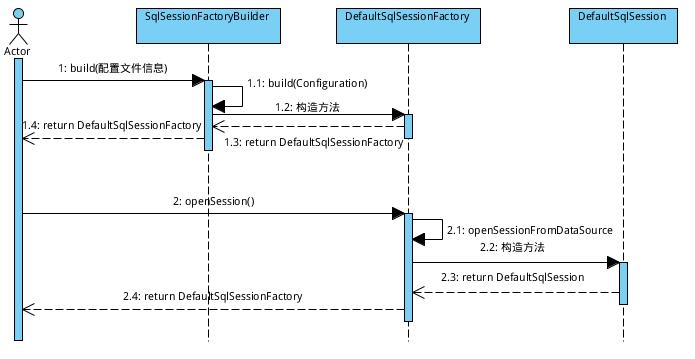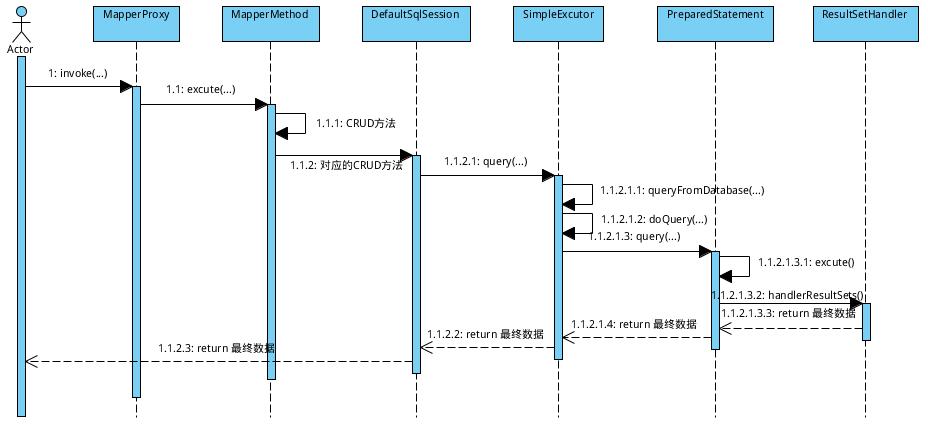Mybatis:MyBatis核心组件介绍原理解析和源码解读
Posted 那啥快看
tags:
篇首语:本文由小常识网(cha138.com)小编为大家整理,主要介绍了Mybatis:MyBatis核心组件介绍原理解析和源码解读相关的知识,希望对你有一定的参考价值。
Mybatis核心成员
- Configuration MyBatis所有的配置信息都保存在Configuration对象之中,配置文件中的大部分配置都会存储到该类中
- SqlSession 作为MyBatis工作的主要顶层API,表示和数据库交互时的会话,完成必要数据库增删改查功能
- Executor MyBatis执行器,是MyBatis 调度的核心,负责SQL语句的生成和查询缓存的维护
- StatementHandler 封装了JDBC Statement操作,负责对JDBC statement 的操作,如设置参数等
- ParameterHandler 负责对用户传递的参数转换成JDBC Statement 所对应的数据类型
- ResultSetHandler 负责将JDBC返回的ResultSet结果集对象转换成List类型的集合
- TypeHandler 负责java数据类型和jdbc数据类型(也可以说是数据表列类型)之间的映射和转换
- MappedStatement MappedStatement维护一条<select|update|delete|insert>节点的封装
- SqlSource 负责根据用户传递的parameterObject,动态地生成SQL语句,将信息封装到BoundSql对象中,并返回
- BoundSql 表示动态生成的SQL语句以及相应的参数信息
以上主要成员在一次数据库操作中基本都会涉及,在SQL操作中重点需要关注的是SQL参数什么时候被设置和结果集怎么转换为JavaBean对象的,这两个过程正好对应StatementHandler和ResultSetHandler类中的处理逻辑。

MyBatis启动原理和源码解析
1. SqlSessionFactory 与 SqlSession.
通过前面的章节对于mybatis 的介绍及使用,大家都能体会到SqlSession的重要性了吧, 没错,从表面上来看,咱们都是通过SqlSession去执行sql语句(注意:是从表面看,实际的待会儿就会讲)。那么咱们就先看看是怎么获取SqlSession的吧:

(1)首先,SqlSessionFactoryBuilder去读取mybatis的配置文件,然后build一个DefaultSqlSessionFactory。
String resource = "mybatis.xml"; // 加载mybatis的配置文件(它也加载关联的映射文件) InputStream inputStream = null; try { inputStream = Resources.getResourceAsStream(resource); } catch (IOException e) { e.printStackTrace(); } // 构建sqlSession的工厂 sessionFactory = new SqlSessionFactoryBuilder().build(inputStream);
源码如下,首先会创建SqlSessionFactory建造者对象,然后由它进行创建SqlSessionFactory。这里用到的是建造者模式,建造者模式最简单的理解就是不手动new对象,而是由其他类来进行对象的创建。更多建造模式学习参阅:设计模式之建造者模式学习理解
// SqlSessionFactoryBuilder类 public SqlSessionFactory build(InputStream inputStream, String environment, Properties properties) { try { XMLConfigBuilder parser = new XMLConfigBuilder(inputStream, environment, properties); return build(parser.parse()); // 开始进行解析了 :) } catch (Exception e) { throw ExceptionFactory.wrapException("Error building SqlSession.", e); } finally { ErrorContext.instance().reset(); try { inputStream.close(); } catch (IOException e) { // Intentionally ignore. Prefer previous error. } } }
通过以上步骤,咱们已经得到SqlSession对象了。接下来就是该干嘛干嘛去了(话说还能干嘛,当然是执行sql语句咯)。
SqlSession咱们也拿到了,咱们可以调用SqlSession中一系列的select..., insert..., update..., delete...方法轻松自如的进行CRUD操作了。 就这样? 那咱配置的映射文件去哪儿了? 别急, 咱们接着往下看:
2. 利器之MapperProxy:

在mybatis中,通过MapperProxy动态代理咱们的dao, 也就是说, 当咱们执行自己写的dao里面的方法的时候,其实是对应的mapperProxy在代理。那么,咱们就看看怎么获取MapperProxy对象吧:
(1)通过SqlSession从Configuration中获取。源码如下:
/** * 什么都不做,直接去configuration中找, 哥就是这么任性 */ @Override public <T> T getMapper(Class<T> type) { return configuration.<T>getMapper(type, this); }
(2)SqlSession把包袱甩给了Configuration, 接下来就看看Configuration。源码如下:
/** * 烫手的山芋,俺不要,你找mapperRegistry去要 * @param type * @param sqlSession * @return */ public <T> T getMapper(Class<T> type, SqlSession sqlSession) { return mapperRegistry.getMapper(type, sqlSession); }
(3)Configuration不要这烫手的山芋,接着甩给了MapperRegistry, 那咱看看MapperRegistry。 源码如下:
/** * 烂活净让我来做了,没法了,下面没人了,我不做谁来做 * @param type * @param sqlSession * @return */ @SuppressWarnings("unchecked") public <T> T getMapper(Class<T> type, SqlSession sqlSession) { //能偷懒的就偷懒,俺把粗活交给MapperProxyFactory去做 final MapperProxyFactory<T> mapperProxyFactory = (MapperProxyFactory<T>) knownMappers.get(type); if (mapperProxyFactory == null) { throw new BindingException("Type " + type + " is not known to the MapperRegistry."); } try { //关键在这儿 return mapperProxyFactory.newInstance(sqlSession); } catch (Exception e) { throw new BindingException("Error getting mapper instance. Cause: " + e, e); } }
(4)MapperProxyFactory是个苦B的人,粗活最终交给它去做了。咱们看看源码:
/** * 别人虐我千百遍,我待别人如初恋 * @param mapperProxy * @return */ @SuppressWarnings("unchecked") protected T newInstance(MapperProxy<T> mapperProxy) { //动态代理我们写的dao接口 return (T) Proxy.newProxyInstance(mapperInterface.getClassLoader(), new Class[] { mapperInterface }, mapperProxy); } public T newInstance(SqlSession sqlSession) { final MapperProxy<T> mapperProxy = new MapperProxy<T>(sqlSession, mapperInterface, methodCache); return newInstance(mapperProxy); }
这里是关键,通过以上的动态代理(更多动态代理知识参阅:java中代理,静态代理,动态代理以及spring aop代理方式,实现原理统一汇总 这篇文章里的动态代理章节),咱们就可以方便地使用dao接口啦, 就像之前咱们写的demo那样:
UserDao userMapper = sqlSession.getMapper(UserDao.class); User insertUser = new User();
这下方便多了吧, 呵呵, 貌似mybatis的源码就这么一回事儿啊。
别急,还没完, 咱们还没看具体是怎么执行sql语句的呢。
3. Excutor:

接下来,咱们才要真正去看sql的执行过程了。
上面,咱们拿到了MapperProxy, 每个MapperProxy对应一个dao接口, 那么咱们在使用的时候,MapperProxy是怎么做的呢? 源码奉上:
MapperProxy:
/** * MapperProxy在执行时会触发此方法 */ @Override public Object invoke(Object proxy, Method method, Object[] args) throws Throwable { if (Object.class.equals(method.getDeclaringClass())) { try { return method.invoke(this, args); } catch (Throwable t) { throw ExceptionUtil.unwrapThrowable(t); } } final MapperMethod mapperMethod = cachedMapperMethod(method); //二话不说,主要交给MapperMethod自己去管 return mapperMethod.execute(sqlSession, args); }
MapperMethod:
/** * 看着代码不少,不过其实就是先判断CRUD类型,然后根据类型去选择到底执行sqlSession中的哪个方法,绕了一圈,又转回sqlSession了 * @param sqlSession * @param args * @return */ public Object execute(SqlSession sqlSession, Object[] args) { Object result; if (SqlCommandType.INSERT == command.getType()) { Object param = method.convertArgsToSqlCommandParam(args); result = rowCountResult(sqlSession.insert(command.getName(), param)); } else if (SqlCommandType.UPDATE == command.getType()) { Object param = method.convertArgsToSqlCommandParam(args); result = rowCountResult(sqlSession.update(command.getName(), param)); } else if (SqlCommandType.DELETE == command.getType()) { Object param = method.convertArgsToSqlCommandParam(args); result = rowCountResult(sqlSession.delete(command.getName(), param)); } else if (SqlCommandType.SELECT == command.getType()) { if (method.returnsVoid() && method.hasResultHandler()) { executeWithResultHandler(sqlSession, args); result = null; } else if (method.returnsMany()) { result = executeForMany(sqlSession, args); } else if (method.returnsMap()) { result = executeForMap(sqlSession, args); } else { Object param = method.convertArgsToSqlCommandParam(args); result = sqlSession.selectOne(command.getName(), param); } } else { throw new BindingException("Unknown execution method for: " + command.getName()); } if (result == null && method.getReturnType().isPrimitive() && !method.returnsVoid()) { throw new BindingException("Mapper method \'" + command.getName() + " attempted to return null from a method with a primitive return type (" + method.getReturnType() + ")."); } return result; }
既然又回到SqlSession了, 那么咱们就看看SqlSession的CRUD方法了,为了省事,还是就选择其中的一个方法来做分析吧。这儿,咱们选择了selectList方法:
public <E> List<E> selectList(String statement, Object parameter, RowBounds rowBounds) { try { MappedStatement ms = configuration.getMappedStatement(statement); //CRUD实际上是交给Excetor去处理, excutor其实也只是穿了个马甲而已,小样,别以为穿个马甲我就不认识你嘞! return executor.query(ms, wrapCollection(parameter), rowBounds, Executor.NO_RESULT_HANDLER); } catch (Exception e) { throw ExceptionFactory.wrapException("Error querying database. Cause: " + e, e); } finally { ErrorContext.instance().reset(); } }
然后,通过一层一层的调用,最终会来到doQuery方法, 这儿咱们就随便找个Excutor看看doQuery方法的实现吧,我这儿选择了SimpleExecutor:
public <E> List<E> doQuery(MappedStatement ms, Object parameter, RowBounds rowBounds, ResultHandler resultHandler, BoundSql boundSql) throws SQLException { Statement stmt = null; try { Configuration configuration = ms.getConfiguration(); StatementHandler handler = configuration.newStatementHandler(wrapper, ms, parameter, rowBounds, resultHandler, boundSql); stmt = prepareStatement(handler, ms.getStatementLog()); //StatementHandler封装了Statement, 让 StatementHandler 去处理 return handler.<E>query(stmt, resultHandler); } finally { closeStatement(stmt); } }
接下来,咱们看看StatementHandler 的一个实现类 PreparedStatementHandler(这也是我们最常用的,封装的是PreparedStatement), 看看它使怎么去处理的:
public <E> List<E> query(Statement statement, ResultHandler resultHandler) throws SQLException { //到此,原形毕露, PreparedStatement, 这个大家都已经滚瓜烂熟了吧 PreparedStatement ps = (PreparedStatement) statement; ps.execute(); //结果交给了ResultSetHandler 去处理 return resultSetHandler.<E> handleResultSets(ps); }
到此, 一次sql的执行流程就完了。
以上是关于Mybatis:MyBatis核心组件介绍原理解析和源码解读的主要内容,如果未能解决你的问题,请参考以下文章